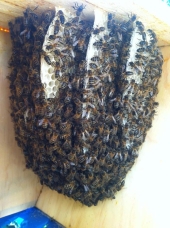




Cool temperate food forest, vegetables, herbs, chickens and bees all Down Under








Moderator, Treatment Free Beekeepers group on Facebook.
https://www.facebook.com/groups/treatmentfreebeekeepers/









Cool temperate food forest, vegetables, herbs, chickens and bees all Down Under




Moderator, Treatment Free Beekeepers group on Facebook.
https://www.facebook.com/groups/treatmentfreebeekeepers/













"You must be the change you want to see in the world." "First they ignore you, then they laugh at you, then they fight you, then you win." --Mahatma Gandhi
"Preach the Gospel always, and if necessary, use words." --Francis of Assisi.
"Family farms work when the whole family works the farm." -- Adam Klaus
 1
1




Ludger Merkens wrote:Hi Chris,
sorry to disappoint. But here in germany putting out bait hives is actually prohibited. No hive material may be made accessible to bees, unless there is actually a living bee hive inside. We are allowed to catch a swarm (if the previous owner abandoned it) and have special rights to enter foreign property for this purpose (rarely used this times, most people are happy, if you remove the swarm), but trapping a hive with a bait hive is not allowed. The reason for this, is to prevent bee deseases from spreading. The same rule, forces a bee keeper to close up a collapsed bee hive (to prevend robbing bees from beeing infected). It would probably be difficult for the ever too often bee illiterate veterinary to distinguish such a disease spin from a proper bait hive (with nice smelling used comb as bee attraction).
Put short - no real live experience using bait hives here.
As for the full sun - to my knowledge bees are best kept in semi shade, with sunlight in the morning and nice protection against strong winds. Still it should not be placed in a pool of cold air.
good luck
Ludger
Moderator, Treatment Free Beekeepers group on Facebook.
https://www.facebook.com/groups/treatmentfreebeekeepers/









My project thread
Agriculture collects solar energy two-dimensionally; but silviculture collects it three dimensionally.





List of Bryant RedHawk's Epic Soil Series Threads We love visitors, that's why we live in a secluded cabin deep in the woods. "Buzzard's Roost (Asnikiye Heca) Farm." Promoting permaculture to save our planet.




Cool temperate food forest, vegetables, herbs, chickens and bees all Down Under








-------------------------------------------------------
Cheers
Rob.

|
So you made a portal in time and started grabbing people. This tiny ad thinks that's rude:
The new kickstarter is now live!
https://www.kickstarter.com/projects/paulwheaton/garden-cards
|




